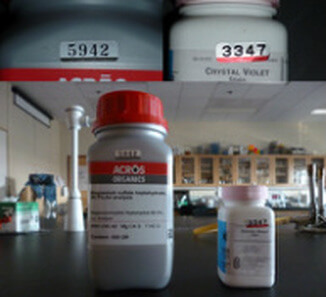CSTEM Chemical Inventory Management
 CSTEM Chemical Inventory
CSTEM Chemical Inventory
There are numerous regulatory requirements requiring the College of Natural Sciences and Mathematics to maintain a chemical inventory. To comply with those requirements, an inventory of hazardous and non-hazardous chemicals within the CSTEM is maintained by the School’s Laboratory Technicians. In general, the chemical inventory is maintained as follows:
- Chemical Received – nearly all chemicals ordered and shipped to the SNS&M are received in a central location.
- Chemical Container “Tagged” – a four-digit inventory sticker is affixed to each chemical container received.
- Chemical Entered into Database – all “tagged” chemicals are entered into a hard copy and electronic database.
- Chemical Inventory Updated – inventory is updated annually and when a Laboratory Technician has been notified that a chemical has been moved to a new location.
- Chemical Logged-Out of Database – when a chemical container is empty or when a chemical is offered for disposal it is logged-out of the chemical inventory database. SNS&M faculty should notify a Laboratory Technician when a container is empty or is to be offered for disposal.
The current inventory stickers affixed to chemical containers are predominantly gray in color and have a black four-digit inventory number. Generally, chemicals received on or before May of 2006 have a sticker with a red stripe and are numbered 1-5000. Chemicals received after May of 2006 have a black stripe and are numbered 5001 or greater. Sample pictures of the inventory stickers are provided above.
Chemical Storage and Usage Guidelines
- Practice “FIRST IN, FIRST OUT” when using chemicals
- Check with the Laboratory Technician prior to placing orders for new chemical reagents
- Do not over purchase chemicals – see the American Chemical Society’s publication Less is Better: Guide to Minimizing Waste in Laboratories for information on purchasing
- Ensure that chemical containers are labeled and legible
- Segregate incompatibles by hazard class
- Open shelves containing chemicals must have a one inch lip to prevent chemicals from falling and to meet storage code
- Do not store chemicals above eye level
- Avoid overcrowding shelves with chemicals
- Chemicals should not be stored on the floor. If unavoidable, secondary containment should be used.
- Secondary containment should be considered when storing liquids that are hazardous.
- Flammable liquids should be stored in flammable cabinets
- Corrosive liquids should be stored in corrosive cabinets (Nitric acid should be stored separate from all other acids.)
- Highly toxic chemicals should be stored in locked cabinets if possible